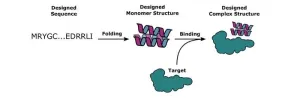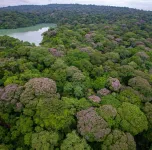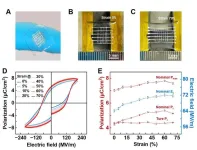(Press-News.org) The key to understanding proteins — such as those that govern cancer, COVID-19, and other diseases — is quite simple. Identify their chemical structure and find which other proteins can bind to them. But there’s a catch.
“The search space for proteins is enormous,” said Brian Coventry, a research scientist with the Institute for Protein Design, University of Washington and The Howard Hughes Medical Institute.
A protein studied by his lab typically is made of 65 amino acids, and with 20 different amino acid choices at each position, there are 65 to the 20th power binding combinations, a number bigger than the estimated number of atoms there are in the universe.
Coventry is the co-author of a study published May 2023 in the journal Nature Communications.
In it his team used deep learning methods to augment existing energy-based physical models in ‘do novo’ or from-scratch computational protein design, resulting in a 10-fold increase in success rates verified in the lab for binding a designed protein with its target protein.
“We showed that you can have a significantly improved pipeline by incorporating deep learning methods to evaluate the quality of the interfaces where hydrogen bonds form or from hydrophobic interactions,” said study co-author Nathaniel Bennett, a post-doctoral scholar at the Institute for Protein Design, University of Washington.
“This is as opposed to trying to exactly enumerate all of these energies by themselves,” he added.
Readers might be familiar with popular examples of deep learning applications such as the language model ChatGPT or the image generator DALL-E.
Deep learning uses computer algorithms to analyze and draw inferences from patterns in data, layering the algorithms to progressively extract higher-level features from the raw input. In the study, deep learning methods were used to learn iterative transformations of representation of the protein sequence and possible structure that very rapidly converge on models that turn out to be very accurate.
The deep learning-augmented de novo protein binder design protocol developed by the authors included the machine learning software tools AlphaFold 2 and also RoseTTA fold, which was developed by the Institute for Protein Design.
Study co-author David Baker, the director of the Institute for Protein Design and an investigator with the Howard Hughes Medical Institute, was awarded a Pathways allocation on the Texas Advanced Computing Center’s (TACC) Frontera supercomputer, which is funded by the National Science Foundation.
The study problem was well-suited for parallelization on Frontera because the protein design trajectories are all independent of one another, meaning that information didn’t need to pass between design trajectories as the compute jobs were running.
“We just split up this problem, which has 2 to 6 million designs in it, and run all of those in parallel on the massive computing resources of Frontera. It has a large amount of CPU nodes on it. And we assigned each of these CPUS to do one of these design trajectories, which let us complete an extremely large number of design trajectories in a feasible time,” said Bennett.
The authors used the RifDock docking program to generate six million protein ‘docks,’ or interactions between potentially bound protein structures, split them into chunks of about 100,000, and assign each chunk to one of Frontera’s 8000+ compute nodes using Linux utilities.
Each of those 100,000 docks would be split into 100 jobs of a thousand proteins each. A thousand proteins go into the computational design software Rosetta, where the 1,000 are first screened at the tenth of the second scale, and the ones that survive are screened at the few-minutes scale.
What’s more, the authors used the software tool ProteinMPNN developed by the Institute for Protein Design to further increase the computational efficiency of generating protein sequences neural networks to over 200 times faster than the previous best software.
The data used in their modeling is yeast surface display binding data, all publicly available and collected by the Institute for Protein Design. In it, tens of thousands of different strands of DNA were ordered to encode a different protein, which the scientists designed.
The DNA was then combined with yeast such that each yeast cell expresses one of the designed proteins on its surface. The yeast cells were then sorted into cells that bind and cells that don’t. In turn, they used tools from the human genome sequencing project to figure out which DNA worked and which DNA didn't work.
Despite the study results that showed a 10-fold increase in the success rate for designed structures to bind on their target protein, there is still a long way to go, according to Coventry.
“We went up an order of magnitude, but we still have three more to go. The future of the research is to increase that success rate even more, and move on to a new class of even harder targets,” he said. Viruses and cancer T-cell receptors are prime examples.
The ways to improve the computationally designed proteins are to make the software tools even more optimized, or to sample more.
Said Coventry: “The bigger the computer we can find, the better the proteins we can make. We are building the tools to make the cancer-fighting drugs of tomorrow. Many of the individual binders that we make could go on to become the drugs that save people's lives. We are making the process to make those drugs better.”
The study,” Improving de novo protein binder design with deep learning,” was published May 6, 2023 in the Journal Nature Communications. The coauthors are Nathaniel R. Bennett, Brian Coventry, Inna Goreshnik, Buwei Huang, Aza Allen, Dionne Vafeados, Ying Po Peng, Justas Dauparas, Minkyung Baek, Lance Stewart, Frank DiMaio, and David Baker of the University of Washington; Steven De Munck and Savvas N. Savvides of Ghent University.
Advancements in Alzheimer’s Disease Research, a gift from Microsoft, the Audacious Project at the Institute for Protein Design, a grant from DARPA supporting the Harnessing Enzymatic Activity for Lifesaving Remedies (HEALR) Program (HR001120S0052 contract HR0011-21-2-0012) the Flanders Institute for Biotechnology, a Strategic Basic Research grant from Research Foundation Flanders, and the Howard Hughes Medical Institute. The authors thanked AWS and Microsoft for generous gifts of cloud computing credits and Texas Advanced Computing Center (TACC) The University of Texas at Austin for providing the CPU resources for all Rosetta design calculations.
END
Deep learning for new protein design
AI-augmented pipeline with Frontera yields ten-fold increase in target binding success
2023-08-03
ELSE PRESS RELEASES FROM THIS DATE:
Scientists uncover a startling—and exploitable—coordination of gene expression in tumors
2023-08-03
AUGUST 3, 2023, NEW YORK – A Ludwig Cancer Research study has identified a pair of genes whose expression by a type of immune cell within tumors is predictive of outcomes for cancer patients and is linked to a vast network of gene expression programs, engaged by multiple cell types in the tumor microenvironment, that control human cancers.
Researchers led by Ludwig Lausanne’s Mikaël Pittet report in the current issue of Science that patients with higher expression of the gene CXCL9 in their tumor-associated macrophages had far better clinical outcomes than those with higher expression of a gene named SPP1 by the immune cells. Macrophages expressing the former ...
Fatal heart disease has plummeted since 1990, but progress has stalled
2023-08-03
After decades of decline, fatal coronary heart disease may rise again unless Americans modify three major risk factors: smoking, drinking, and obesity.
A Rutgers study just published in American Heart Journal found that deaths from coronary heart disease among people ages 25 to 84 dropped to 236,953 in 2019 from 397,623 in 1990, even though Americans’ median age increased to 38 from 33 over the last three decades.
Between 1990 and 2019, the US age-standardized coronary heart disease mortality rate per 100,000 fell from 210.5 to 66.8 for females (4 percent decline per year) and from 442.4 to 156.7 for males (3.7 percent decline per year). However, the decline has slowed significantly ...
UCF, MIT designing technology to fight bacterial infections, improve aquaculture farming
2023-08-03
UCF, MIT Designing Technology To Fight Bacterial Infections, Improve Aquaculture Farming
BY SUHTLING WONG | AUGUST 3, 2023 11:11 AM
UCF and MIT researchers are using farm-raised seafood as a model to create new technologies that fight pathogenic bacteria.
University of Central College of Medicine microbiologist Dr. Salvador Almagro-Moreno and Massachusetts Institute of Technology's Dr. Otto Cordero were recently awarded a grant from the National Science Foundation to create synthetic microbiomes – communities of microorganisms – that will better protect aquatic environments from bacteria.
The team ...
Researchers discuss the ethical challenges of studying DNA from a 18th–19th century African American community
2023-08-03
A population genetics team recently identified the genetic relationship between over 40,000 23andMe users and a population of enslaved and free African Americans that lived in Catoctin Furnace, Maryland between 1776–1850. Over the course of this study, the researchers considered how best to inform descendants and other genetic relatives of their genetic connection to the site. The group has published their considerations and the ethical questions they have encountered on August 3rd in the American Journal of Human Genetics.
“This study required us to consider several ethical issues that had not been explicitly addressed in the existing literature ...
Tropical trees use social distancing to maintain biodiversity
2023-08-03
Tropical forests often harbor hundreds of species of trees in a square mile, but scientists often struggle to understand how such a diversity of species can coexist. In a study published in Science, researchers at The University of Texas at Austin have provided new insights into the answer by uncovering a key characteristic of the spatial distribution of adult trees.
Combining computational modeling with data collected during a 30-year period, the researchers discovered that adult trees in a Panamanian forest are three times as distant from other adults of the same species as what the proverbial “the apple doesn’t fall far from ...
Ferroelectric material is now elastic
2023-08-03
A research group led by Prof. LI Runwei at the Ningbo Institute of Materials Technology and Engineering (NIMTE) of the Chinese Academy of Sciences (CAS) have proposed a "slight crosslinking" method that imparts elastic recovery to ferroelectric materials.
The study was published in Science.
Ferroelectric materials are very useful for applications such as data storage and processing, sensing, energy conversion, and optoelectronics, etc., making them highly desirable in mobile phones, tablets and other ...
Editorial: Turning the tide on obesity?
2023-08-03
In an Editorial, Cynthia Bulik and Andrew Hardaway highlight the recent advances in medical treatments for obesity and weight loss. “With the emergence of new, highly effective weight-loss drugs, might the ‘fat decades’ become a closed chapter in the history of public health?” ask the authors. The “obesity epidemic” is a global health concern, with more than a billion people affected by obesity and many more overweight. Although various environmental, biological, and behavioral factors have been implicated in obesity, few consistently effective treatments exist for the disease. Recently, however, new weight-loss ...
Compensation for damages can and should address social and cultural impacts
2023-08-03
In this Policy Forum, Robin Gregory and colleagues highlight how a suite of methodological approaches can be used to bring less tangible social and cultural losses that marginalized groups incur into the formal compensation assessment framework. “Though the issues and approaches we describe are applicable in many contexts,” the authors write, “we illustrate them … with a focus on Indigenous communities, for whom the neglect of social and cultural losses in assessments of compensation ...
Adult tropical trees of the same species grow farther apart than factors like seed dispersal limits can explain
2023-08-03
Tropical trees distance themselves from members of their own species more than they do other species, a new study shows. What’s more, trees of the same species exist at distances farther apart than would be expected by chance or the limits of seed dispersal. The results reveal pervasive within-species spatial repulsion in adult trees, providing new insights into the ecological dynamics that stabilize species diversity and enable the exceptionally high diversity of tropical forests. Tropical forests host an unusually high diversity of tree species. For example, some tropical forests contain more than 250 tree species per hectare. However, how hundreds of species coexist on relatively small ...
A gut hormone for controlling appetite doubles as an immune regulator for the fungal microbiome
2023-08-03
Peptide YY (PYY), a hormone produced by gut endocrine cells that was already known to control appetite, also plays an important role in maintaining the balance of fungi in the digestive system of mammals, according to new research from the University of Chicago.
In a study published this week in Science, researchers found that specialized immune cells in the small intestine called Paneth cells express a form of PYY that prevents the fungus Candida albicans from turning into its more virulent form. PYY was already known to be produced by endocrine cells in the gut as a hormone that signals satiety, or when an animal has had enough to eat. The new research shows that it also ...
LAST 30 PRESS RELEASES:
How human interaction drove evolution to make bears less aggressive
National Poll: Few parents offer teens guidance on healthy eating during holiday season
Cannabis derivatives could provide new ovarian cancer treatments
Raising strong yeast as a petroleum substitute
Clues to the origin of hot Jupiters hidden in their orbits
Canada’s reduced pledge to Global Fund will impact domestic health
1 in 4 children with major traumatic injuries not cared for in pediatric trauma centres
Duke and Duke-NUS’ joint cross-population research to uncover "East-West" differences in disease and care
Scientists to ‘spy’ on cancer- immune cell interactions using quantum technology breakthrough
Tech savvy users have most digital concerns
Making lighter work of calculating fluid and heat flow
Normalizing blood sugar can halve heart attack risk
Lowering blood sugar cuts heart attack risk in people with prediabetes
Study links genetic variants to risk of blinding eye disease in premature infants
Non-opioid ‘pain sponge’ therapy halts cartilage degeneration and relieves chronic pain
AI can pick up cultural values by mimicking how kids learn
China’s ecological redlines offer fast track to 30 x 30 global conservation goal
Invisible indoor threats: emerging household contaminants and their growing risks to human health
Adding antibody treatment to chemo boosts outcomes for children with rare cancer
Germline pathogenic variants among women without a history of breast cancer
Tanning beds triple melanoma risk, potentially causing broad DNA damage
Unique bond identified as key to viral infection speed
Indoor tanning makes youthful skin much older on a genetic level
Mouse model sheds new light on the causes and potential solutions to human GI problems linked to muscular dystrophy
The Journal of Nuclear Medicine ahead-of-print tip sheet: December 12, 2025
Smarter tools for peering into the microscopic world
Applications open for funding to conduct research in the Kinsey Institute archives
Global measure underestimates the severity of food insecurity
Child survivors of critical illness are missing out on timely follow up care
Risk-based vs annual breast cancer screening / the WISDOM randomized clinical trial
[Press-News.org] Deep learning for new protein designAI-augmented pipeline with Frontera yields ten-fold increase in target binding success





